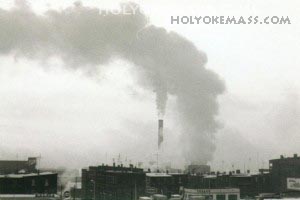by Laurel | April 19th, 2010
Slightly flowery, but interesting description of the dangerous job of chimney maintenance for the mills.
April 19, 1903
Now Working At Holyoke.
Joseph Wilson and His Spectacular Work
Among the careers of danger and daring there is none which holds a firmer place in the popular mind than that of Joseph Wilson, climber of mill chimneys, who made his second visit to Holyoke this week.
The deep-sea diver disappearing over the side of his boat into the blue waters is fascinating to grown-ups as well as to small boys, but the imagination often fails to follow him, Not so with the chimney climber. There he stands on his trail-looking staging close to the top of the big chimney, with dense black smoke whirling in the wind crowning him first with an ugly cloud, next leaving him standing headless, and finally leaving his head without a body resting on a cloud of smoke. Wilson, in truth, from his position on the big chimney of the Whiting paper company, enviable to the Holyoke newsboy and quite the opposite to most of us, has become something of a local hero — a real hero, not of books but of life. There is an additional interest also in the fact that he is also one of the most expert climbers of American mill chimneys with a labor-saving and money-saving plan.
Holyoke is a fine type of the large manufacturing center, with its almost never-ceasing roar of waters, its endless humming, throbbing engines, its score of tall chimneys — sentinels of the day and the height ever obscuring the stars with their black contents. Each chimney, too, centers about a heart with its main artery in the counting-room, whose beating must never cease. Approaching danger to future efficiency is the signal, therefore, for calling an expert not only with courage and daring, but with skill enough to work without the great industrial monster knowing or feeling it — for calling a Wilson to Holyoke.
Wilson, as has has been intimated, is a man with a plan, whoever may have invented it. He repairs chimneys for one thing, builds them up, takes them down, without building a staging from the ground. Though the chimney may need pointing at the bottom, it is more often that the wind, rain, and freaky lightening injure its top. The problem is, therefore, to have a staging at the top on which to work without building one 125 or 200 feet from the ground. How this can be done has been seen here this week. With a long chain of ladders lashed together securely and fastened also by means of spikes driven here and there between the bricks the top was reached. The next move was to draw up a spruce plank with two bolt-holes in it and rest it horizontally on a row of spikes. Dropping over the other side of the chimney in his boatswain chair, he prepares another board in the same way, and then proceeds by means of bolts to draw them so closely to the chimney that they cannot move. The scheme is aided, of course, bu the tapering shape of the structure. The foundation for a staging is thus laid with speed not easily appreciated except by the observer.
Chimney climbing with Wilson is a profession. He has followed it since early manhood. It is just about 16 years ago this month that as a young man of 20 he appeared at the yard of R. B. Hilton & Son, contractors at Preston, Lancashire, England, ready for work. Though born in that place, the son of a hand weaver, he was to follow quite a different line of work. He learned the trade of a bricklayer — the essential trade for one who was to follow the business of chimney climbing. “In the old country,” as he says, many chimney were climbed, and England owns some of the highest. At the plant of the Star paper mill in England, Wilson made the highest climb of his life — 298 feet. He came to American in 1897, and since that time has repaired scores of mill chimneys. The factory insurance companies have also called on him to make chimney inspection tours, thus opening a new branch of the trade. With the erection of the larger mills, the amount of work has increased rapidly, as one might well imagine by a sweeping glance over this city. Still the competition is said not to be strenuous, and with the tendency of in chimneys as shown by that of the Clark thread mill at Newark, N.J., and that of the American printing company at Fall River, it will probably not increase. Already Wilson, with his men, have visited many of the New England and central states, and is fast becoming a well-known figure in the Connecticut Valley.
From The Springfield Republican.









